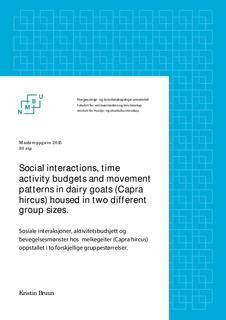| dc.contributor.author | Bruun, Kristin | |
| dc.date.accessioned | 2015-07-10T12:10:03Z | |
| dc.date.available | 2015-07-10T12:10:03Z | |
| dc.date.copyright | 2015 | |
| dc.date.issued | 2015-07-10 | |
| dc.identifier.uri | http://hdl.handle.net/11250/293082 | |
| dc.description.abstract | Goats are, like most farm animals, group living animals. In todays animal husbandry of goats there is considerable variation in group size. Larger group sizes are generally associated with less aggressive interactions and more movement activity. In this thesis the main objective was to examine the effect of group size on social interactions, activity time budgets and movement patterns in Norwegian dairy goats. The experiment was conducted at the goat barn at the Norwegian University of Life Sciences (NMBU).
During this study a total of 90 pregnant goats were used. Out of those 36 were semi-randomly selected to look at the effects of group size. The goats were housed in two different group sizes; 6 and 24, and space per animal was 1.4 m2. The goats remained in the same group throughout the experiment. The experiment was performed with three observation periods with both direct observations and video observations of social interactions, activity budget and movement patterns (November, December / January and January / February). A mixed model analysis of variance was used to analyse the effect of group size, week and time on social interactions, activity time budgets and movement patterns.
The results show that there was a higher frequency of defensive behaviour (P = 0.02) and a tendency towards more social activity (P = 0.07) in goats housed in large group than goats housed in small groups. In small groups, there was a higher frequency of resting than in large groups (P = 0.01). Goats in large groups were more active and had a higher frequency of moving (P <0.0001) and moved generally larger total distances (P <0.0001) than goats in small groups. The distance to the "furthest neighbour" was smaller in small groups than in large groups (P <0.0001). The goats had a smaller distance to “nearest neighbour” in the first and third time period than during the second in the two first observational weeks (P <0.0001). During the first and third time period 57.7% ± 1.9% and 58.8% ± 1.8% of the behaviours performed were feeding, whereas 63.7% ± 2.5% of the behaviours performed in the second time period was resting. | nb_NO |
| dc.publisher | Norwegian University of Life Sciences, Ås | |
| dc.title | Social interactions, time activity budgets and movement patterns in dairy goats (Capra circus) housed in two different group sizes | nb_NO |
| dc.title.alternative | Sosiale interaksjoner, aktivitetsbudsjett og bevegelsmønster hos melkegeiter (Capra hircus) oppstallet i to forskjellige gruppestørrelser | nb_NO |
| dc.type | Master thesis | nb_NO |
| dc.subject.nsi | VDP::Agriculture and fishery disciplines: 900::Agriculture disciplines: 910::Other agricultural disciplines: 919 | nb_NO |
| dc.subject.nsi | VDP::Mathematics and natural science: 400::Zoology and botany: 480::Ethology: 485 | nb_NO |
| dc.source.pagenumber | 65 | nb_NO |
| dc.description.localcode | M-HV | nb_NO |
